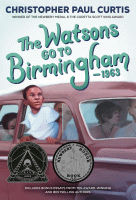Christopher Paul Curtis is an award-winning author of children’s novels and chapter books, including the Newbery Medal-winning book, Bud, Not Buddy, and the Newbery Honor-winning book, The Watsons Go to Birmingham—1963. Having spent the bulk of his young-adult years working in factories and warehouses, Curtis is truly a late-bloomer in the literary world. However, that has not held back this well-spoken man who is passionate about his craft. Here, Christopher Paul Curtis shares with Mackin’s Amy Meythaler how his writing journey began and where the adventure will take readers next.
Discovering the Writer Within
You came to writing in quite an unusual fashion and at a later age. How is it that a factory worker from Michigan could transition into an award-winning writer so smoothly?
Well, it wasn’t so smoothly. I worked in the factory for 13 years after high school, and I absolutely hated it. However, I feel like it was responsible for me becoming a writer. I would work 30-minute shifts and then have 30 minutes off every hour. I found that if I stopped and wrote during my breaks, it made me stop thinking about the factory and how unhappy I was.
After 13 years, I quit the factory and had a series of menial jobs like mowing lawns or doing apartment maintenance. I finally got a steady job outside Detroit in Windsor at ADP where I was in charge of the warehouse. I ended up taking a year off to try to write a book. (I was about 42 years old at the time.) During that year I wrote The Watsons Go to Birmingham—1963 and Mr. Chickee’s Funny Money at the same time.
As a writer, you don’t see royalties for a long, long time; so I went back to work. I was at the warehouse one day when I got a phone call from a principal in a nearby school. He had read my book and wondered if I would come speak to the kids. He said they didn’t have a lot of money but offered me $300. Now, I was making about $250 a week, so $300 for an hour sounded great! I’ve always gotten along with young people and seem to have a rapport with them. So, after a while I got more and more speaking engagements. After about three years after the Watsons book came out, I was able to quit my job and write full time.
I was very grateful.
“Kate DiCamillo and I both became authors on a similar path—both working at warehouses. That can give people hope. Fight for your dreams. Do what you want to do. Work at it. Don’t be crazy and quit your job, but work at what you want to do. There is the possibility—and Kate DiCamillo is a good example—if you have what it takes, there is the possibility that you can be recognized and do wonderful things.”
Many of your books are centered on difficult times in American history. Yet, into each book you magically weave humor with tragedy and feeling with fact. How did you develop your distinctive writing style?
Comedy and tragedy are so intertwined. I see humor in a lot of tragic things, and I see tragedy in a lot of funny things. It is a balancing act of weaving the two without being overwhelmed by either one.
I was a good writer throughout elementary, middle, and high school; but I didn’t enjoy it. I think my time in the factory let me see how powerful a tool writing can be. It made a difference in my life and led to making differences in the lives of my readers.
I was also a really, really good reader as a child—I was reading at a 12th grade level in 6th grade—but I didn’t like novels. I read magazines and comics. I liked Time, National Geographic, and Batman! I would also read Popular Mechanics and Popular Science. In the factory during my breaks, part of the time I was writing and part of the time I was reading. That is when I really developed a love of reading. I learned not only writing takes you places, but also reading does too.
With your writing, do you have a set process? Do you outline or journal?
No, I don’t outline so I have no real clear idea of where a story is going as I’m writing. And sometimes I will write it one way and then go back and do some research and find some of the things I may have referenced didn’t even come out until 10 years later. So, I have to go back and rewrite. I also don’t journal every day. I do journal, in a sense, when I write each book. I will get a 300-page spiral-bound notebook. Every day I put the place and time where I am writing and a summary about what I’m working on. This lets me know where a story is going, and I can look back and decide if the current direction is the right way or if I should go back to a previous idea.
I tend to write from things I know and things I’ve researched. With the Watsons book, I wrote it as a family story. I grew up in a family, so I know all about that. I also know a good bit about the civil rights movement because my parents very much pushed us to read about it and to be knowledgeable about it. But with language, a lot of the things we say today just didn’t exist in the past. There are some things you have to do research on to make the stories realistic. So a lot of my research includes how to capture how people spoke at a certain time.
The Internet has made research a lot easier. For the Watsons book, it was a very time intensive process. But when I wrote The Mighty Miss Malone, I could go to the Internet. For example, there is a scene about Deza’s father going out on Lake Michigan. I had to know the water temperature in an exact area on a specific date, and the Internet brings it all up. There is no excuse for shoddy, sloppy research.
Do you carve out a specific time and place for your writing?
No, I am not a regimented writer, and that is a problem. I’ve learned the main thing is you have to show up. Generally, I wake up at 5:00 or 6:00 every morning. Then I take care of stuff around the house. Then I take the Detroit People Mover over to the Renaissance Center at the GM Headquarters. It is open all the time and has a nice area where I go sit and write for about four hours. Then I go home.
I used to go to the library to write, but I chose the Renaissance Center when I moved to Detroit. I like to be in a place where people are always milling around. There, people can talk to you or you can focus in on doing your work.
I’ve discovered the most important thing is that you have to look at writing as a job and get up and go. I feel more comfortable being somewhere other than home. I go to the Renaissance Center and do what I have to do.
When I’ve got a book pretty much done, I’ll take a train ride from Windsor up to Montreal. It is a 12-hour ride each way. I don’t know anyone on the train and nobody knows me, so I have concentrated time to put into the book. By the time I’m back home, I usually have the book finished.
Remembering the Sacrifices and Successes
September 15, 2013, marks the 50th anniversary of the 16th Street Baptist Church bombing in Birmingham, Alabama. Did you ever expect your book to become such a major component in remembering the event and those who died?
Well, the Watsons book is dedicated to the four young girls, but I had no idea the book would be so closely associated with the event. There is such a dearth of historical fiction relating to African-American subjects. I think that is one of the reasons the book is tied in so closely to the event.
I had originally written the book as The Watsons go to Florida—1963. It was about the whole family going to Florida; but once they got there, nothing happened. I was later introduced to the poem Ballad of Birmingham and knew immediately that the Watsons needed to go to Birmingham. That’s when I knew how the story would go. It made all the difference in the world.
I can remember the bombing; I was 10 years old. It is hard to realize that much time has gone by. We’ve accomplished so much since then, but we still have so far to go.
For many children, The Watsons Go to Birmingham—1963 is their introduction to a major event in the civil rights movement. Why do you believe it is so important for children to be exposed to such ugly tragedies as the church bombing?
We have examples every day of what happens when you are not exposed to or aware of what is going on. In fact, a lot of young people think Martin Luther King and Abraham Lincoln were contemporaries!
We have examples every day of what happens when you are not exposed to or aware of what is going on. In fact, a lot of young people think Martin Luther King and Abraham Lincoln were contemporaries!
I think that there is not the appreciation today of what people went through before. There is not a lot of appreciation for the fact that kids can go to school and get an education—they don’t have to drop out after 6th grade to work in a field or to go to a menial job. It is very important that we let them know what was done and that we emphasize the heroism of the people who took part in this.
There was a spirit in this country in the 1950s and 1960s when so many people, black and white and Protestant and Catholic, people who gave the ultimate sacrifice for the rights of others—all for saying, “This is wrong. We have to change this.” They knew they would get beaten or even die. These people were heroic, and we have not done enough to recognize them.
“A hero is somebody who does something selfless—it is people who are trying to improve a situation for others even though it may not necessarily improve things for themselves.”
To me, the term “hero” is far, far overused. A hero is somebody who does something selfless—it is people who are trying to improve a situation for others even though it may not necessarily improve things for themselves. It is important for us to let young people know what was done—that people lost their lives, their jobs, were horribly injured, or were destroyed. Young people owe it to those people to take care of business when they go to school and when they present themselves to the world. They must give that respect. We have to keep letting our young people know “This was done for you. Now you need to take care of business.”
Football players, baseball players, and basketball players are not heroes. A person who puts everything on the line so young people can get an education and use that education to get a job, that person deserves the title of hero. Those are the people who need to be celebrated.
The Watsons book is a story about family but also about the way the civil rights movement affected the family. It was just one incident in their lives but still a very important one.
In September, The Watsons Go to Birmingham is being released as a movie on the Hallmark Channel and as a Birmingham Children’s Theatre production in October. Did you have a role in developing the screenplay or the script?
Reginald André Jackson did a beautiful job on the play from the script I’ve seen. The movie has taken nearly 20 years to come to the screen. Whoopi Goldberg had the rights for about six years, and then Tonya Lewis Lee and Nikki Silver had it for nine years before it sold. When they first got it, they gave me the script to review. A lot of it is very true to the book, but I know that a movie and a book are two different animals. They have to cut a lot, and things have to be done for dramatic effect. I’m not a screenwriter or a dramatist, so I left that to the people who could do it.
What I’ve seen of the Hallmark movie looks excellent. The young people who carry the movie are spectacular—they are total professionals. I’ve seen the trailer and it is beautifully done. I’m very proud of that and am starting to get excited. They are going to have an initial screening in Flint (Michigan) and in Birmingham (Alabama), and I will be at both.
My appreciation for performances of my books has grown since I saw the Chicago Children’s Theatre perform Bud, Not Buddy earlier this year. I saw it four or five times, and each one was very emotional for me. One of the reasons I believe it was an emotional experience is because my mother had died about three months before the play debuted. As I remember the play and the book, they were about a young boy searching for his father. But once I saw the play, I realized how much of the story was really also about the quest to fill the hole that losing his mother had left. Once I saw that, I cried. I’m very proud of the production.
You were awarded the Newbery Medal for Bud, Not Buddy. In fact, you were the first African-American male to receive the honor. What was that achievement like for you and was it made any sweeter knowing you made history?
When I first got the call, I thought it was my sister playing a joke on me! I am proud of the achievement, but I also feel strangely because there are a lot of good books that have not been recognized over the years. And, only three authors have been African American. There have been even fewer Hispanic authors. I’m proud of the honor, but I also recognize there needs to be a whole lot more fiction from different perspectives. That is what makes reading so worthwhile—exposing kids to other things.
Revealing the Future
Speaking of exposure to different things, your Mr. Chickee books take on a very different tone than your other titles. How did you discover and develop the story lines and the antics and adventures of Steven and Russell? Will we see more from them in the future?
Well, I was writing the Watsons book at the same time I wrote Mr. Chickee’s Funny Money. As a new writer, I would get fed up with the Watson characters—you know, Kenny’s whining and Joetta doing this or that and Byron being an idiot. Instead of putting it down, I would take breaks and read magazines. Then it occurred to me that I was supposed to be writing, so I chose to write. I started writing a new series that was light and airy as a counterpoint to the Watsons, and that is how I came to Mr. Chickee’s Funny Money. I finished it and put it aside. Later, I dug it out, reworked it, and sent it in.
“Awards are recognition that what authors do is worthwhile. An award is not a waste of time; it is a way to say you did a good job. That is something everybody needs to hear.”
I want to do another Mr. Chickee book. Mr. Chickee’s Funny Money and Mr. Chickee’s Messy Mission were mostly about Steven and then Russell. I want the third one to focus on Richelle Cyrus-Herndon. I think that might be the last book because they will find what they are looking for, but I want this one to be more substantial than the first two. I have the ending, I just need to sit down and write the book. Maybe I’ll do that when I’m working on something else.
There is exciting news to share about Mr. Chickee’s Funny Money—it is opening next year as a musical at Chicago Children’s Theatre before moving off Broadway in New York. One of the cool things is that Lamont Dozier (who wrote one of my favorite songs ever—Bernadette by the Four Tops) is writing all the music for Mr. Chickee’s Funny Money!
Can you give us a hint as to what else you might be working on now or in the near future?
I am currently putting the finishing touches on The Madman of Piney Woods about damaged people and redemption. It takes place in 1901 in Buxton, Ontario, and is told in alternating chapters from the perspectives of an African-Canadian boy named Benji and an Irish boy known as “Red.” I knew I could write Benji’s side of the story easily but I thought the Irish boy’s story would be difficult to tell. I was surprised when I finished because Benji was overwhelmed by Red. I’m now working to bolster Benji’s side of the story. I’m also starting another Buxton book. I know the characters but I’m not quite sure yet what is going to happen.
Quick Facts
Born
May 10 in Flint, Michigan
Currently Lives
Detroit, Michigan
Previous Jobs
Factory worker, campaign worker, maintenance man, customer service representative, warehouse clerk, purchasing clerk
Hobbies
Playing basketball, collecting old record albums, writing
Inspiration for Writing
I believe that young people are often blessed with the best ears for detecting what rings true or what feels right in a particular piece of writing. To me the highest accolade comes when a young reader tells me, “I really liked your book.” The young seem to be able to say ‘really’ with a clarity, a faith, and an honesty that we adults have long forgotten. That is why I write.
Synopsis of The Watsons Go to Birmingham—1963
First published in 1995, The Watsons Go to Birmingham—1963 follows a middle-class black family around the time of the 1963 16th Street Baptist Church bombing in Birmingham, Alabama. Narrated by Kenny, the Watson’s 10-year-old son, this middle-grade historical novel introduces students to a critical event in the American civil-rights movement.
Having sold 2.4 million copies in all editions of the book, The Watsons Go To Birmingham—1963 is a staple in classrooms nationwide. It has received numerous awards, including:
- Newbery Honor
- Coretta Scott King Award
- Golden Kite Award
- ALA Best Book for Young Adults
- ALA Notable Children’s Book
- Booklist 25 Top Black History Picks for Youth
- NCSS-CBC Notable Children’s Trade Book in the Field of Social Studies
- Children’s Book Committee at Bank Street College Best Book of the Year
- New York Times Best Book
- Publishers Weekly Best Book
- Horn Book Fanfare
- Bulletin Blue Ribbon
- California Young Reader Medal
On September 20, 2013, the Hallmark Channel will debut The Watsons Go to Birmingham—1963 movie produced by Walden Media, ARC Entertainment, and Tonik Productions. The screenplay was written by Tonya Lewis Lee, executive produced by Lee and Emmy® Award winner Nikki Silver, and directed by Tony® Award Nominee Kenny Leon. The movie features Tony® Award Winner and Grammy® Award Nominee Anika Noni Rose, Three-time Tony® Award and Grammy® Award Nominee David Alan Grier, Skai Jackson, LaTanya Richardson, Wood Harris, Bryce Jenkins, and Harrison Knight. Check local listings for air times.
Reflections
“The Watsons Go to Birmingham—1963 was one of the first novels written for kids that I had read since I was a kid. That’s an unnecessarily convoluted sentence. What I mean to say is that I read the book as an adult, and thought: I didn’t know that you could do this with a kid’s book, that you could tell the truth and also make the truth bearable.
“I read the book and thought: I want to try and do this. I want to write a book like this. I typed up chapters of the book on my word processor to get a feel for how long a kid’s novel would be, and also to try and understand how Curtis worked his magic.
“I keep trying to write books like The Watsons. Books that are funny. And true. And necessary.”
“I’ve met him a couple times. The first time, I hugged him. He is very tall. I was basically embracing his knees.”
“What struck me the first time I read Christopher Paul Curtis was the humor. Although he tackles serious subjects like segregation and discrimination. Curtis’s humor is universal. Anyone with siblings will recognize themselves in ‘the Watsons’ and how satisfying it is to torture the gullible youngest child.”
Kate DiCamillo
Award-winning Author of Flora & Ulysses: The Illuminated Adventures
“Good children’s literature puts us in the minds of others, great children’s literature creates a world for us that we wouldn’t have otherwise entered and changes how we think and feel. Curtis does this one book at a time.”
Lisa Von Drasek
Curator of Children’s Literature Research Collections Kerlan Collection at the University of Minnesota
Excerpt from The Watsons Go To Birmingham—1963
 And You Wonder Why We Get Called the Weird Watsons
And You Wonder Why We Get Called the Weird Watsons
It was one of those super-duper-cold Saturdays. One of those days that when you breathed out your breath kind of hung frozen in the air like a hunk of smoke and you could walk along and look exactly like a train blowing out big, fat, white puffs of smoke.
It was so cold that if you were stupid enough to go outside your eyes would automatically blink a thousand times all by themselves, probably so the juice inside of them wouldn’t freeze up. It was so cold that if you spit, the slob would be an ice cube before it hit the ground. It was about a zillion degrees below zero.
It was even cold inside our house. We put sweaters and hats and scarves and three pairs of socks on and still were cold. The thermostat was turned all the way up and the furnace was banging and sounding like it was about to blow up but it still felt like Jack Frost had moved in with us.
All of my family sat real close together on the couch under a blanket. Dad said this would generate a little heat but he didn’t have to tell us this, it seemed like the cold automatically made us want to get together and huddle up. My little sister, Joetta, sat in the middle and all you could see were her eyes because she had a scarf wrapped around her head. I was next to her and on the outside was my mother.
Momma was the only one who wasn’t born in Flint so the cold was coldest to her. All you could see were her eyes too, and they were shooting bad looks at Dad. She always blamed him for bringing her all the way from Alabama to Michigan, a state she called a giant icebox. Dad was bundled next to Joey, trying to look at anything but Momma. Next to Dad, sitting with a little space between them, was my older brother, Byron.
Byron had just turned thirteen so he was officially a teenage juvenile delinquent and didn’t think it was “cool” to touch anybody or let anybody touch him, even if it meant he froze to death. Byron had tucked the blanket between him and Dad down into the cushion of the couch to make sure he couldn’t be touched.
Dad turned on the TV to try to make us forget how cold we were but all that did was get him in trouble. There was a special news report on Channel 12 telling how bad the weather was and Dad groaned when the guy said, “If you think it’s cold now, wait until tonight, the temperature is expected to drop into record-low territory, possibly reaching the negative twenties! In fact, we won’t be seeing anything above zero for the next four to five days!” He was smiling when he said this but none of the Watson family thought it was funny. We all looked over at Dad. He just shook his head and pulled the blanket over his eyes.
Then the guy on the TV said, “Here’s a little something we can use to brighten our spirits and give us some hope for the future: The temperature in Atlanta, Georgia is forecast to reach . . .” Dad coughed real loud and jumped off the couch to turn the TV off but we all heard the weatherman say, “. . . the mid-seventies!” The guy might as well have tied Dad to a tree and said, “Ready, aim, fire!”
“Atlanta!” Momma said. “That’s a hundred and fifty miles from home!”
“Wilona . . . ,” Dad said.
“I knew it,” Momma said. “I knew I should have listened to Moses Henderson!”
“Who?” I asked.
Dad said, “Oh Lord, not that sorry story. You’ve got to let me tell about what happened with him.”
Momma said, “There’s not a whole lot to tell, just a story about a young girl who made a bad choice. But if you do tell it, make sure you get all the facts right.”
We all huddled as close as we could get because we knew Dad was going to try to make us forget about being cold by cutting up. Me and Joey started smiling right away, and Byron tried to look cool and bored.
“Kids,” Dad said, “I almost wasn’t your father. You guys came real close to having a clown for a daddy named Hambone Henderson. . . .”
“Daniel Watson, you stop right there. You’re the one who started that ‘Hambone’ nonsense. Before you started that everyone called him his Christian name, Moses. And he was a respectable boy too, he wasn’t a clown at all.”
“But the name stuck didn’t it? Hambone Henderson. Me and your granddaddy called him that because the boy had a head shaped like a hambone, had more knots and bumps on his head than a dinosaur. So as you guys sit here giving me these dirty looks because it’s a little chilly outside ask yourselves if you’d rather be a little cold or go through life being known as the Hambonettes.”
Me and Joey cracked up, Byron kind of chuckled and Momma put her hand over her mouth. She did this whenever she was going to give a smile because she had a great big gap between her front teeth. If Momma thought something was funny, first you’d see her trying to keep her lips together to hide the gap, then, if the smile got to be too strong, you’d see the gap for a hot second before Momma’s hand would come up to cover it, then she’d crack up too.
Laughing only encouraged Dad to cut up more, so when he saw the whole family thinking he was funny he really started putting on a show.
Excerpted from The Watsons Go to Birmingham—1963 by Christopher Paul Curtis. Excerpted by permission of Yearling, a division of Random House LLC. All rights reserved. No part of this excerpt may be reproduced or reprinted without permission in writing from the publisher.
Teaching Ideas from The Watsons Go To Birmingham—1963
Thematic Connections
Humor–Humor is woven throughout the book. Examples include Byron’s lips getting stuck to the side mirror of the car (pp. 12—14), Daniel mimicking Moses Henderson (pp. 4—5), and Byron’s frozen people story (pp. 51—54). Have students reread what they feel is the funniest passage. Then have them write a funny passage they would like to add to this novel.
Family/Parental Relationships–Byron’s mother threatens to set him on fire if he continues to play with matches (pp. 66—74). This is an unbelievable punishment that she almost carries out. Was it right of Byron’s mother to choose such a harmful punishment? Was she bluffing to frighten Byron? How would it be viewed today?
Getting Along With Others–Have students examine Kenny’s passage about bullying (pp. 58—63) and discuss alternatives to bullying. When should mediation intervene? How do you avoid such situations? Brainstorm to develop solutions.
Friendship–Kenny becomes a real friend of Rufus, but realizes that he has damaged their relationship when he joins in laughing at Rufus on the bus (pp. 43—46). Have students write about a situation in which they slighted someone without just cause, how they felt afterward, and what they did about it. How does Kenny’s acknowledgment of his injustice help to correct it (p. 45)?
Sibling Relationships–Have students compare and contrast the three Watson children by using a Venn Diagram or a web. What are the class’s impressions of the three? How would you describe Kenny and Byron’s relationship? How does it change? Have students write about their own sibling relationships and compare them to the Watsons.
Interdisciplinary Connections
History/Civil Rights–Life in 1963 was quite different for African Americans than it is today, especially in the South. Have students find inferences that blacks and whites were treated differently (pp. 5—6). Check reference books for historical details of the Birmingham church bombing and look for the names of the young girls listed on the “In Memory of” page. Probe the question raised by Kenny (p. 199), “Why would they hurt some little kids like that?” Have students create a class book on “What America Was Like When the Watsons Went to Birmingham in 1963.”
Language/Language Arts–Kenny often refers to his mother and father as “talking Southern.” Consult your media center to secure tapes of language patterns of various regions. Have students tape-record the speech of relatives with regional accents. Provide a preset passage for each speaker to read. In a listening activity, play the tapes for your students and see if they can detect the different speech patterns.
Geography–Wilona plans to discuss all the states she and her family drive through on their trip from Flint, Michigan, to Birmingham, Alabama. Use pushpins and yarn to chart the trip on a class map, down I-75 beginning in Flint and ending in Birmingham. Have students research each state that the family passes through and the major cities along I-75. Discuss what the Watsons might have seen.
Science–Throughout the novel there is a continuous discussion among family members about the merits of Michigan and Birmingham winters. As the novel opens, Kenny describes the day as being “a zillion degrees below zero” (p. 1). In a funny episode, Byron gets his lips stuck to the side-view mirror of the car in subzero weather. Discuss what could have caused Byron’s lips to stick to the mirror. How does skin freeze to ice? Have a dialogue with students about some of the properties of water–i.e., its freezing point being °320 F (00 C) and its expansion as it freezes. Have students conduct the following simple activities:
- 1. The Sticking Ice Tray–Needed: a tray of ice just out of the freezer. Note that the tray will stick to your fingers. Here’s why: If the tray and ice cubes are below the freezing point of water, the warmth of the hand will melt a thin layer of frost. Then, as the hand is cooled, the layer of water will freeze again. It is possible that the hand or finger can freeze so tightly to the tray that a little skin is torn as it is pulled loose.
- 2. Freeze with Fingers–Needed: two ice cubes. Press the cubes together, one flat surface tightly against the other. They will freeze together. Here’s why: The increase in pressure lowers the melting point and some of the ice melts where they are in contact; then the water freezes again as the pressure is reduced.
Pre-reading Activity
Recreate the time period of the novel, having students list what they know about the early 1960s (how people dressed, the mood of the country, people who were in the news, music that was popular, etc.). Then have them create a time line of events that took place from 1960—1970 so a historical connection can be made to the time during which this novel takes place. Ask students who have records or tapes of 1960s music (especially African American music) to bring them in to share with the class. Later, compare that music to music mentioned in the novel. (“Yakety Yak” is Kenny’s favorite!)






